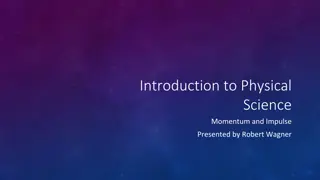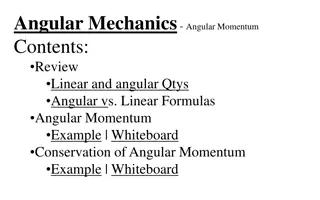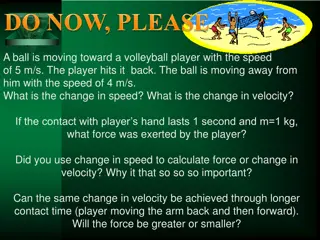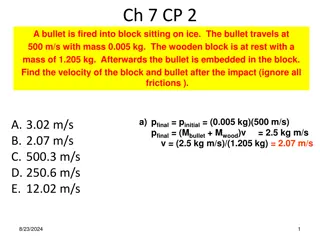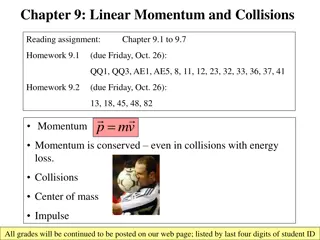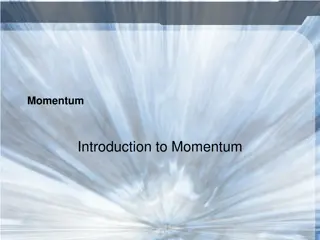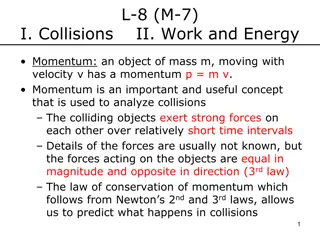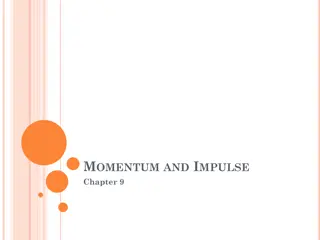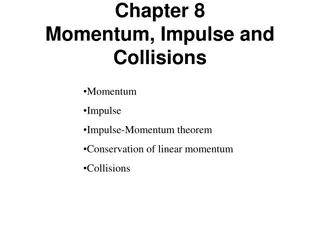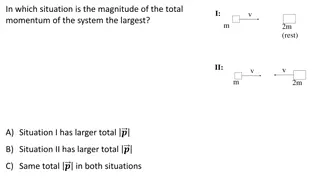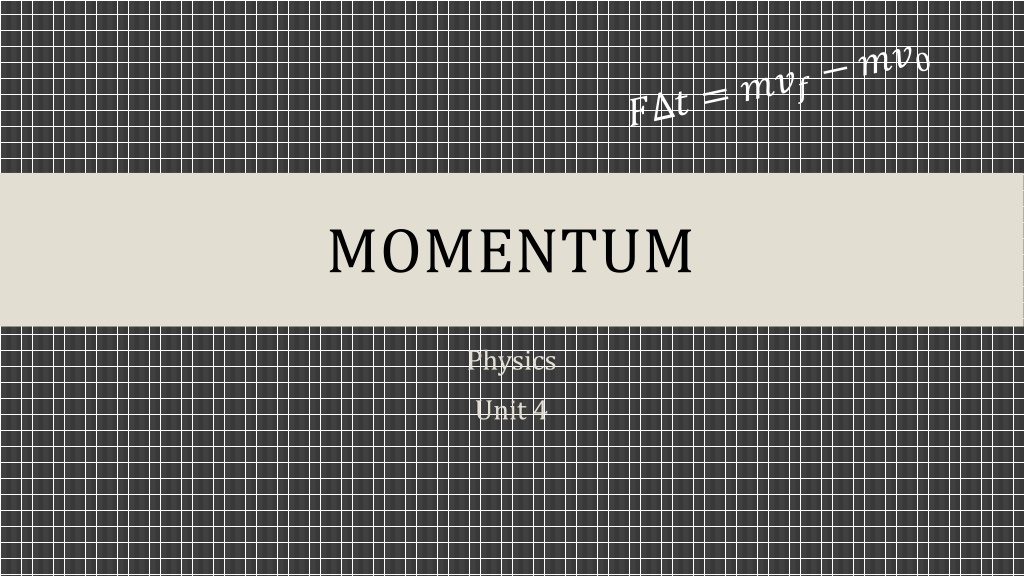
Understanding Impulse and Momentum in Physics
Learn about impulse, linear momentum, and the relationship between force and momentum in everyday scenarios. Explore how time of force application impacts object response and delve into the concept of impulse as a change in momentum. Discover the importance of momentum in collisions and how to calculate impulse using the impulse-momentum theorem.
Download Presentation

Please find below an Image/Link to download the presentation.
The content on the website is provided AS IS for your information and personal use only. It may not be sold, licensed, or shared on other websites without obtaining consent from the author. If you encounter any issues during the download, it is possible that the publisher has removed the file from their server.
You are allowed to download the files provided on this website for personal or commercial use, subject to the condition that they are used lawfully. All files are the property of their respective owners.
The content on the website is provided AS IS for your information and personal use only. It may not be sold, licensed, or shared on other websites without obtaining consent from the author.
E N D
Presentation Transcript
MOMENTUM Physics Unit 4
CREDITS This Slideshow was developed to accompany the textbook OpenStax High School Physics Available for free at https://openstax.org/details/books/physics By Paul Peter Urone and Roger Hinrichs 2020 edition Some examples and diagrams are taken from the OpenStax College Physics, Physics, and Cutnell & Johnson Physics 6th ed. Slides created by Richard Wright, Andrews Academy rwright@andrews.edu
04-01 IMPULSE AND MOMENTUM In this lesson you will Define impulse and linear momentum. Explain the relationship between momentum and force. Describe effects of impulses in everyday life.
04-01 IMPULSE AND MOMENTUM Often the force acting on an object is not constant. Baseball or Tennis ball being hit Times of force often short Force can be huge
04-01 IMPULSE AND MOMENTUM To hit a ball well Both size of force and time of contact are important Bring both these together in concept of impulse
04-01 IMPULSE AND MOMENTUM Impulse ? = ? ? Unit: Ns Is a vector
04-01 IMPULSE AND MOMENTUM Object responds to amount of impulse Large impulse Large response higher vf Large mass less velocity Both mass and velocity play role in how responds to impulse
04-01 IMPULSE AND MOMENTUM Linear Momentum ? = ?? Unit: kg m/s Is a vector Is important when talking about collisions
04-01 IMPULSE AND MOMENTUM ? = ?? ? =?? ?0 ? =??? ??0 ? = ??? ?0 ? ? = ??? ??0 ? ?
04-01 IMPULSE AND MOMENTUM Impulse = Change in Momentum Hard to measure force during contact Find change in momentum Use impulse-Momentum Theorem and time of contact to find average force of contact
04-01 IMPULSE AND MOMENTUM In the following video Watch for the front of the car crumpling This increase the time of the collision Which decreases the force of the collision Given that the change in momentum is constant What other crash safety feature increases the time of collision?
04-01 IMPULSE AND MOMENTUM A baseball (m = 0.14 kg) with initial velocity of 40 m/s (90 mph) is hit. It leaves the bat with a velocity of 60 m/s after 0.001 s. What is the impulse and average net force applied to the ball by the bat? Impulse = 14 Ns F = 14000 N
04-01 IMPULSE AND MOMENTUM A raindrop (m= 0.001 kg) hits a roof of a car at 15 m/s. After it hits, it spatters so the effective final velocity is 0. The time of impact is 0.01 s. What is the average force? F = 1.5 N What if it is ice so that it bounces off at 10 m/s? F = 2.5 N
04-01 IMPULSE AND MOMENTUM In the following video Old cars don t have crumple zones Notice that the new car is much safer than the old car.
04-02 CONSERVATION OF MOMENTUM In this lesson you will Describe the principle of conservation of momentum. Derive an expression for the conservation of momentum. Explain conservation of momentum with examples.
04-01B BUMPER TESTING LAB 1. Each team makes a bumper out of paper and tape. a. 2.5 cm 4 cm 10 cm b. Do not use excessive tape 2. The bumper is placed against the end of the track. 3. The cart is released from a distance as set by the teacher. 4. The maximum force is read from the sensor.
04-02 CONSERVATION OF MOMENTUM Do the lab in your worksheet. Explain why if a person standing of frictionless ice shoots a bullet at 200 m/s does not move backwards are 200 m/s. A 100 kg person pushes off from a 50 kg person on frictionless ice. If the 100 kg person moves at 3 m/s, what speed will the 50 kg person move at?
04-02 CONSERVATION OF MOMENTUM System All the objects involved in the problem Usually only two objects Internal Forces Forces that the objects exert on each other External Forces Forces exerted by things outside of the system
04-02 CONSERVATION OF MOMENTUM Two balls hit in the air During the collision Internal Forces = F12 and F21 External Forces = Weight (W1 and W2)
04-02 CONSERVATION OF MOMENTUM ? ? = ??? ??0 Object 1: ?1+ ?12 t = m1vf1 m1v01 Object 2: ?2+ ?21 t = m2vf2 m2v02 Add ?1+ ?2+ ?12+ ?21 t = m1vf1+ m2vf2 m1v01+ m2v02 ??? ? + ??? ? ? = ?? ?0
04-02 CONSERVATION OF MOMENTUM Since F12 and F21 are equal and opposite Sum of internal forces = 0 External Forces ? = ?? ?0 If Isolated system: 0 = ?? ?0 OR ?0= ??
04-02 CONSERVATION OF MOMENTUM Law of Conservation of Momentum In an isolated system the total momentum remains constant ?0= ?? System can contain any number of objects Crash Video Watch Crash Video
Notice how the lighter car always bounces backwards. Conservation of Momentum predicts this
04-02 CONSERVATION OF MOMENTUM Reasoning Strategy 1. Decide on the system 2. Identify internal and external forces 3. Is the system isolated? If no, then can t use conservation of momentum 4. Set the total initial momentum of the isolated system equal to the total final momentum
04-02 CONSERVATION OF MOMENTUM Two billiard balls are colliding on a table. In order to apply the law of conservation of momentum, what should the system be? One ball or both billiard balls? Two billiard balls. External Forces: Weight and Normal Force If the table is horizontal these cancel If it were one ball, then the force of the second ball hitting it would not cancel with anything.
04-02 CONSERVATION OF MOMENTUM A hockey puck of mass 0.17 kg and velocity 5 m/s is caught by a 0.5 kg mitten laying on the ice. What is the combined velocity after the puck is in the mitten? (ignore friction) v = 1.27 m/s
04-02 CONSERVATION OF MOMENTUM A 5 kg baseball pitching machine is placed on some frictionless ice. It shoots a 0.15 kg baseball horizontally at 35 m/s. How fast is the pitching machine moving after it shoots the ball? 1.05 m/s This is why you feel recoil when you shoot a gun
04-03 ELASTIC AND INELASTIC COLLISIONS In this lesson you will Describe an elastic collision of two objects in one dimension. Determine the final velocities in an elastic collision given masses and initial velocities. Define inelastic collision. Explain perfectly inelastic collision.
04-03 ELASTIC AND INELASTIC COLLISIONS Newton s Cradle Lab 3. Lay the ruler perfectly horizontal and put the marbles in the center touching each other. 4. From one end, roll a marble so that it hits the other four. What happens? 5. From one end, roll two marbles so that it hits the other three. What happens? 6. From one end, roll three marbles so that it hits the other two. What happens? 7. From one end, roll four marbles so that it hits the other one. What happens? 8. Roll one marble extra fast to try to get two marbles to come out at half the speed. 9. If a marble of mass m comes in at velocity v and stops and an identical marble flies out the other side, what will its velocity have to be to conserve momentum? 10. Show that momentum was conserved in steps 3-7. 11. Show that momentum would be conserved in step 7, but kinetic energy would not be conserved if two marbles came out at half the speed.
04-03 ELASTIC AND INELASTIC COLLISIONS Kinetic Energy Energy of motion ?? =1 2??2
04-03 ELASTIC AND INELASTIC COLLISIONS Subatomic kinetic energy often conserved Macroscopic kinetic energy usually not conserved Converted into heat Converted into distortion or damage
04-03 ELASTIC AND INELASTIC COLLISIONS Elastic kinetic energy conserved Inelastic kinetic energy not conserved Completely inelastic the objects stick together
Bumpers are supposed to protect your car from minor accidents and provide elastic collisions are low speeds
04-03 ELASTIC AND INELASTIC COLLISIONS You are playing marbles. Your 0.10 kg shooter traveling at 1.0 m/s hits a stationary 0.050 kg cat s eye marble. If it is an elastic collision what are the velocities after the collision? vc = 1.33 m/s vs = .333 m/s
04-03 ELASTIC AND INELASTIC COLLISIONS Police will sometime reconstruct car accidents. In one accident, the cars stuck together and slid 12 m before they stopped. They measure the coefficient of friction as 0.70. The blue car s mass is 1100 kg and was sitting still at a stop sign when it was hit by the red car whose mass is 990 kg. How fast was the red car going when it hit the blue car?
What can you do to stay safer in a car crash?
04-04 ANGULAR MOMENTUM In this lesson you will Understand the analogy between angular momentum and linear momentum. Observe the relationship between torque and angular momentum. Apply the law of conservation of angular momentum.
04-04 ANGULAR MOMENTUM Linear momentum p = mv When you rotate something you exert a torque. More torque = faster change in angular momentum Angular momentum L = I ????= ? ? Like ? = ? Unit: kg m2/s must be in rad/s ?
04-04 ANGULAR MOMENTUM Linear momentum of a system is conserved if ????= 0 p0 = pf Angular momentum of a system is also conserved if ????= 0 L0 = Lf
04-04 ANGULAR MOMENTUM A 10-kg solid disk with r = 0.40 m is spinning at 8 rad/s. A 9-kg solid disk with r = 0.30 m is dropped onto the first disk. If the second disk was initially not rotating, what is the angular velocity after the disks are together? = 5.31 rad/s What was the torque applied by the first disk onto the second if the collision takes 0.01 s? ? = 215 Nm
04-04 ANGULAR MOMENTUM Angular Momentum conserved if net external torque is zero Linear Momentum conserved if net external force is zero Kinetic Energy conserved if elastic collision
04-04 ANGULAR MOMENTUM Direction of angular quantities Right-hand Rule Hold hand out with thumb out along axis Curl your fingers in direction of motion(you may have to turn your hand upside down) vector in direction of thumb
04-04 ANGULAR MOMENTUM A person is holding a spinning bicycle wheel while he stands on a stationary frictionless turntable. What will happen if he suddenly flips the bicycle wheel over so that it is spinning in the opposite direction?

